An Interview With An ArtRage Artist
Stephen Rasche-Hilpert is a German equine photographer and portrait artist who uses his photography and love of horses to create beautiful, heartfelt paintings in ArtRage.
Stephen Rasche-Hilpert ist ein deutscher Pferdefotograf und Porträtkünstler, der seine Fotografie und seine Pferdeliebe anwendet, um schöne, ausdrucksvolle Gemälde in ArtRage zu erschaffen.
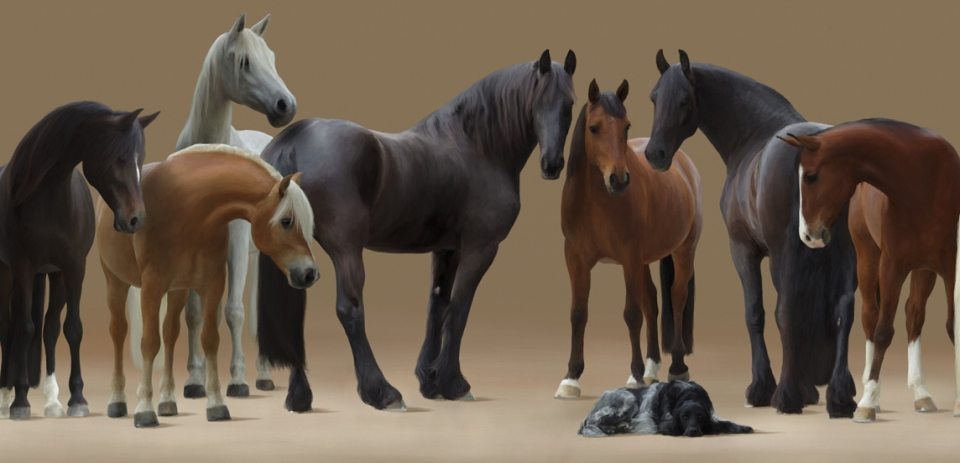
This interview is in both English and German. English questions and answers are on the left. German questions and answers are on the right. Any language mistakes are made by Ambient Design staff.
Dieses Interview ist auf Englisch und Deutsch vorhanden. Die englische Version der Fragen und Antworten befindet sich auf der linken Seite, die deutsche auf der rechten. Eventuelle Übersetzungsfehler wurden vom Ambient Design Personal gemacht.
ArtRage Editions: ArtRage 4.5, ArtRage for iPad
Platforms: Mac OS 10.9, iPad
Background: Digital Art
Website: www.equidographie.de (read in English)
Who are you? What do you want the internet to know about you?
I am an equine photographer and digital artist based in Germany.
Horses play a very important part in my life. I have been working almost exclusively with them for just over a decade now. Actually, to be honest, you could say that horses are my life, I suppose. We live on a little farm in the North of Germany, and a large part of spring and summer is spent traveling the country for equine photo shoots. I mostly work on private commission and am best known for my natural light portraiture, but my work includes all facets of equine photography except studio work. Last fall we had a great time celebrating our 650th private equine portrait session.
Wer bist du? Was soll das Internet von dir wissen?
Ich bin Pferdefotograf und digitaler Künstler und lebe in Deutschland.
Pferde spielen eine wichtige Rolle in meinem Leben. Ich arbeite seit etwas über einem Jahrzehnt ausschließlich mit ihnen, und um ehrlich zu sein, könnte man wohl sagen, dass Pferde mein Leben sind. Wir wohnen auf einem Resthof in Schleswig-Holstein, und einen großen Teil des Frühlings und des Sommers verbringen wir auf Reisen zu Fototerminen im gesamten Bundesgebiet. Ich arbeite hauptsächlich in privatem Auftrag, und ich bin bekannt für meine Portraits mit natürlichem Licht, aber meine Arbeit umfasst alle Facetten der Pferdefotografie außer Studioaufnahmen. Im letzen Herbst hatten wir sehr viel Spaß, als wir unsere 650. Einzelportraitsitzung feiern konnten.
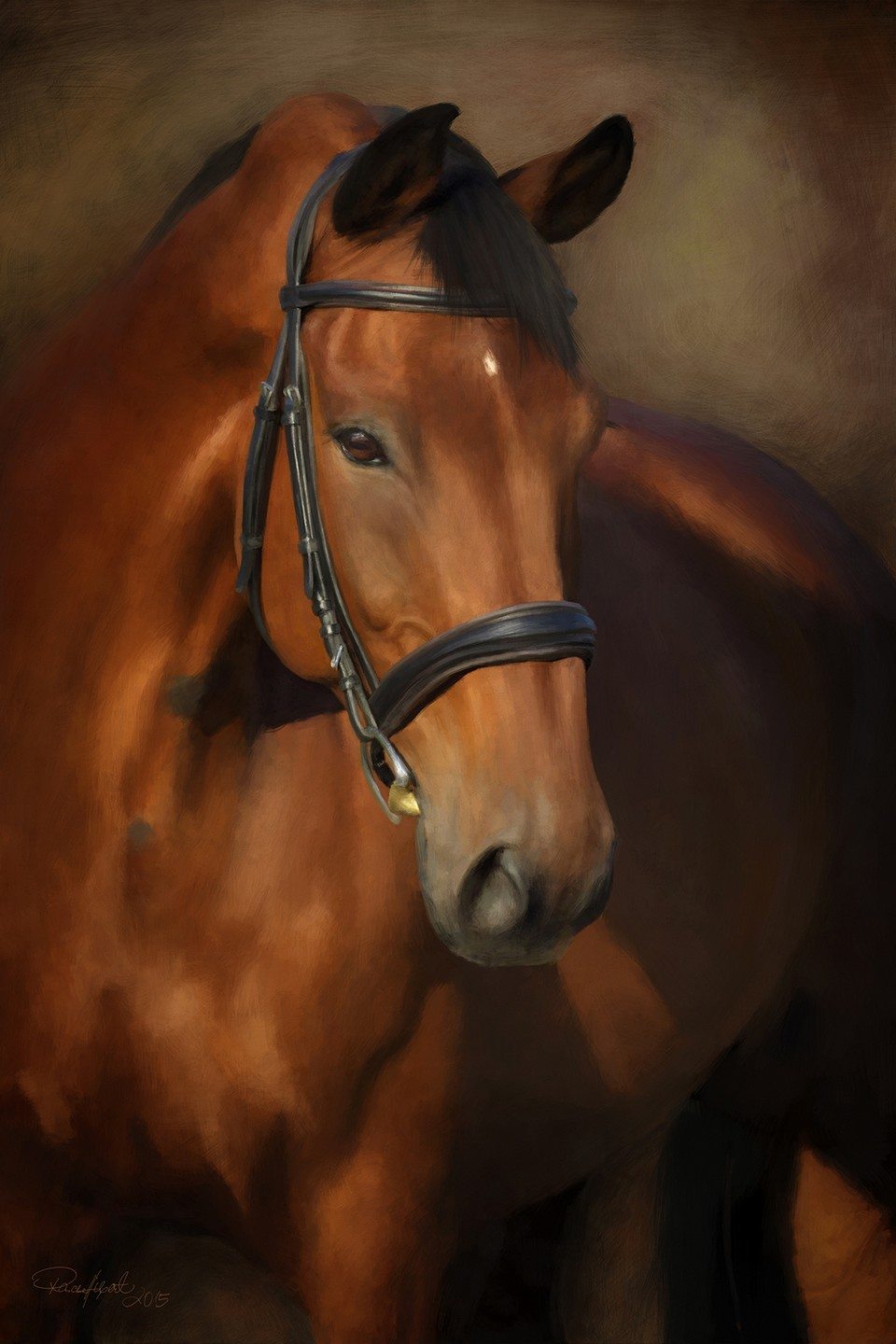
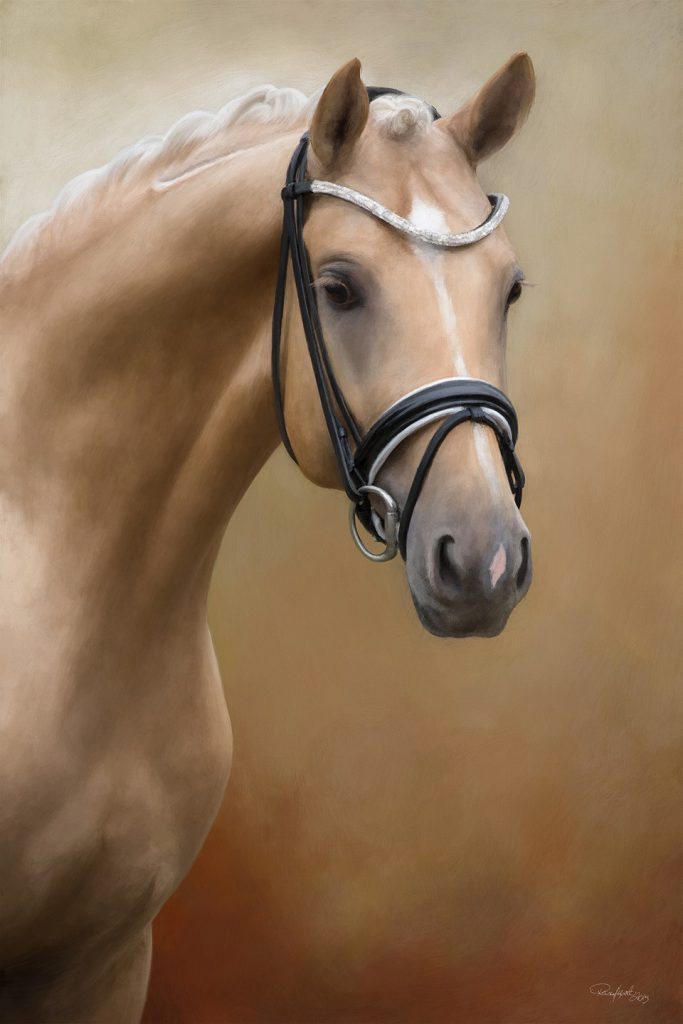
I went to high school and college in the United States and studied Cultural Sciences and Linguistics at the University of Hamburg here in Germany. I have always been interested in art and literature, but it took many years of doing all kinds of things until I came across photography and digital art as being what you might consider my calling. Next to my commercial and privately commissioned work as a photographer, I have done design work for web and print, worked as a writer, and I have won distinctions at a couple of international art contests. In 2012 I was commissioned as photographer/artist/author of the illustrated book “Noble. Dignified. Beautiful. The Quiet Elegance of the Horse” by one of Germany’s largest publishing houses for equine literature. Coming from a book-loving family, this was a dream come true.
Being asked by ArtRage to be included in the ranks of their featured artists still seems like a dream. What an honor!
Ich bin in den Vereinigten Staaten zur High School und zum College gegangen und habe an der Universität Hamburg Kultur- und Sprachwissenschaften studiert. Kunst und Literatur haben mich schon immer interessiert, aber ich habe viel Jahre alles mögliche getan, bis ich auf die Fotografie und die digitale Kunst gestoßen bin und entdeckte, dass sie meine Berufung sind. Neben meiner fotografischen Arbeit für gewerbliche und private Auftraggeber habe ich für Print und Web gestaltet, geschrieben, und ich habe ein paar Auszeichnungen bei internationalen Kunstwettbewerben gewonnen. 2012 wurde mir von einem der wichtigsten Verlage für Pferdeliteratur in Deutschland ein Vertrag als Fotograf/Künstler/Autor des Bildbandes „Adel. Würde. Schönheit. Die stille Eleganz der Pferde“ angeboten. Ich stamme aus einer buchverrückten Familie, und mit diesem Projekt wurde eine Lebenstraum wahr.
Von ArtRage in die Reihe ihrer Featured Artists aufgenommen zu werden, ist wieder ein wahr gewordener Traum. Was für eine Ehre!
Equine Photography from Stephen Rasche-Hilpert
What kind of artist are you? What kind of subjects do you draw? (How would you describe your style and/or theme?)
I found my way to painting digitally through my photography. I am greatly indebted to my own horses – all horses, really – and I try to show every horse I work with in a way as to inspire awe at its beauty, its elegance, its dignity. These are qualities, in turn, that inspire respect for the living creature, and that is what drives me in my work: I want the people who look at my pictures to respect the horses for what they are, individuals who deserve to be treated well and respected in their needs. It is my way of showing gratitude for what my horses have done for me. It’s not merit in sports or breeding – they kept me going when nothing else would, simply by being who and what they are.
So it’s horses – mostly.
I have been influenced by artists of the past, especially George Stubbs, and I think that my style could best be described as rather conservative. A couple of years ago, I found out that my 12 times great-grandfather was Lucas Cranach the Elder, an important German artist of the Renaissance. I found that inspiring, too.
Was für eine Art Künstler bist du? Welche Art von Motiven malst du? (Wie würdest du deinen Stil und/oder deine Ausrichtung beschreiben?)
Ich habe durch meine Fotografie zum digitalen Malen gefunden. Ich bin meinen eigenen Pferden – allen Pferden, eigentlich – zu großem Dank verpflichtet, und ich versuche, jedes Pferd, mit dem ich arbeite, auf eine Art und Weise zu zeigen, die Achtung vor seiner Schönheit, seiner Eleganz und seiner Würde bewirkt. Dies sind Eigenschaften, die einem Respekt abverlangen, und das ist es, was mich bei meiner Arbeit antreibt: Ich möchte, dass die Betrachter meiner Bilder den Pferden den ihnen gebührenden Respekt zollen. Sie sind Individuen, die es verdient haben, nach ihren Bedürfnissen gut behandelt zu werden. Es ist meine Art, meine Dankbarkeit für das auszudrücken, was meine Pferde für mich getan haben. Es waren keine Leistungen im Sport oder in der Zucht. Sie haben mich mit dem, was sie sie sind und wer sie sind, aufgerichtet, als nichts und niemand anderes dazu in der Lage war.
Pferde also – meistens.
Ich wurde von Künstlern der Vergangenheit beeinflusst, besonders von George Stubbs, und ich denke, dass mein Stil am ehesten als etwas konservativ beschrieben werden kann. Vor ein paar Jahren erfuhr ich, dass mein 12-mal Urgroßvater Lucas Cranach der Ältere war. Er war einer der wichtigsten deutschen Künstler der Renaissance, und auch das fand ich inspirierend.
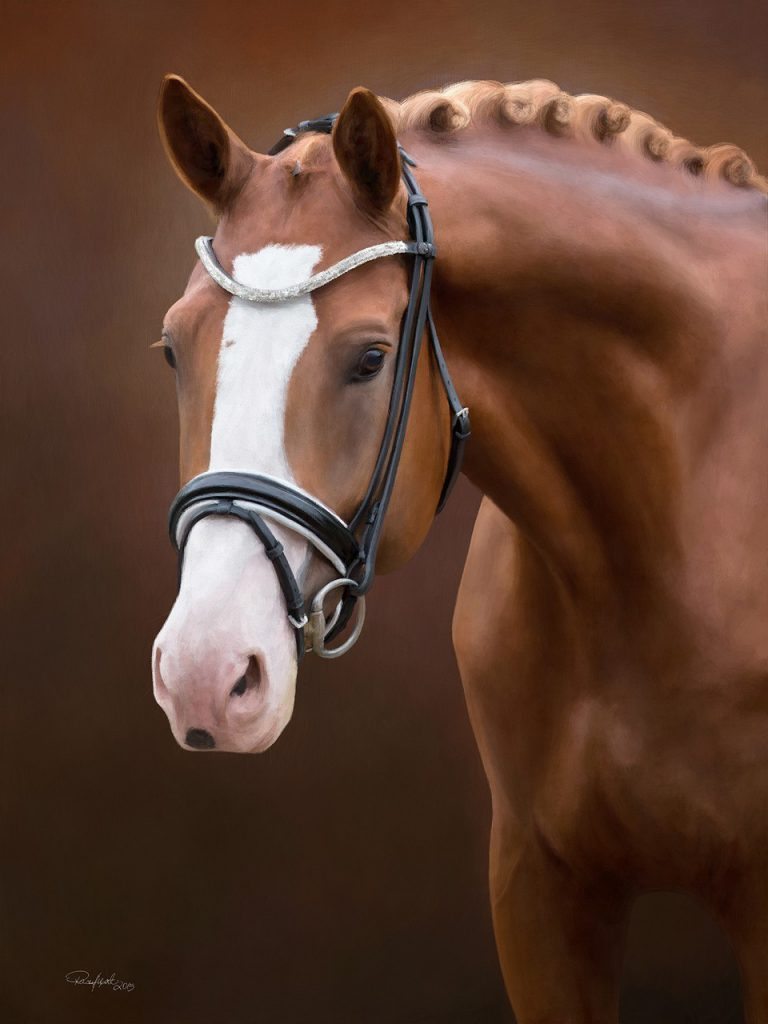
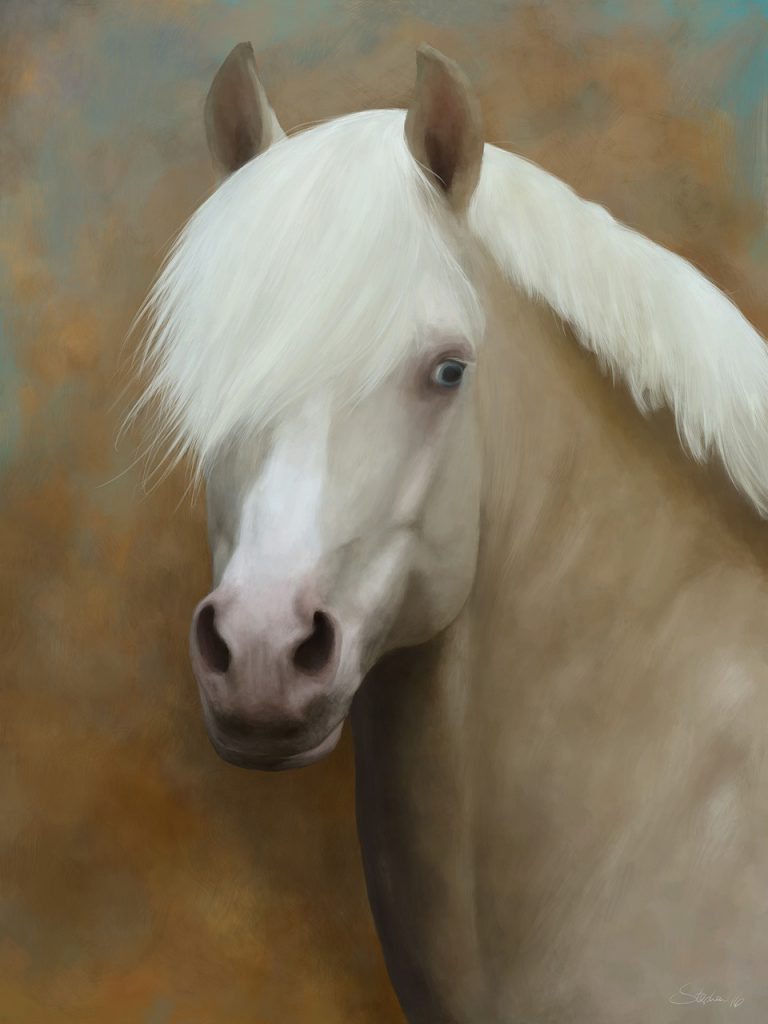
Do you come from a digital or traditional art background?
I have never done any serious work outside of the digital realm.
How long have you been using ArtRage?
For about two and a half years.
How did you come across the program?
Not intentionally, lol! I had felt that I had come to an end of what I could do in Photoshop to create my visions. There was a definite need to move on, and I was introduced to Corel Painter by a very good friend of mine. I had, of course, seen many outstanding works of art created in Painter, but as hard as I tried, the program remained a closed book to me. I returned to Photoshop, frustrated. I then re-discovered that I had an old version of ArtRage on my computer that must have come with a graphics tablet at some point. I had played around with it years ago and then forgot about it (strange for me to think today that I could actually forget about it!). I had another try and it was instant love. The intuitive design and the natural interaction of tools and paints with the canvas have never lost their fascination since that day.
Do you use other programs or traditional media?
My first phase of digital art was done in Photoshop, and I think I did take it quite far, but ever since I started working with ArtRage, Photoshop has been reserved for photo editing and upscaling ArtRage paintings. I have also done some work in Procreate.
No, I do not work with traditional media.
Ist deine künstlerische Herkunft digital oder traditionell?
Ich habe niemals ernst zu nehmende Projekte außerhalb der digitalen Welt in Angriff genommen.
Wie lange arbeitest du schon mit ArtRage?
Seit etwa zweieinhalb Jahren.
Wie bist du dem Programm begegnet?
Nicht absichtlich, *lach*. Ich hatte das Gefühl, dass ich am Ende war mit dem, was ich in Photoshop leisten konnte, um meine Visionen sichtbar zu machen. Ich hatte das starke Bedürfnis, mich weiterzuentwickeln, und so hat mir eine sehr gute Freundin Corel Painter näher gebracht, doch so sehr ich mich auch bemühte, das Programm blieb für mich wie mit sieben Siegeln verschlossen. Frustriert ging ich zurück zu Photoshop. Durch Zufall fiel mir eine alte Version von ArtRage ein, die ich auf dem Computer hatte. Sie muss irgendwann einmal mit einem Grafiktablett gekommen sein. Ich hatte zwar vor einigen Jahren einmal kurz mit ihr herumgespielt, sie dann aber wieder vergessen (wie seltsam es heute klingt, dass ich es tatsächlich vergessen haben konnte!). Ich versuchte es erneut, und ich verliebte mich sofort. Das intuitive Design und das natürliche Zusammenspiel von Werkzeugen und Farben mit der Leinwand haben seither ihre Faszination nicht verloren.
Arbeitest du auch mit anderen Programmen oder traditionellen Medien?
Meine erste Phase digitaler Kunst hat vollständig in Photoshop stattgefunden, und ich glaube, dass ich es auch relativ weit getrieben habe, aber seit ich angefangen habe, mit ArtRage zu arbeiten, bleibt Photoshop dem Foto-Editing und der Druckvorbereitung von ArtRage-Bildern vorbehalten. Ich habe auch mit Procreate gearbeitet.
Nein, ich arbeite nicht mit traditionellen Medien.
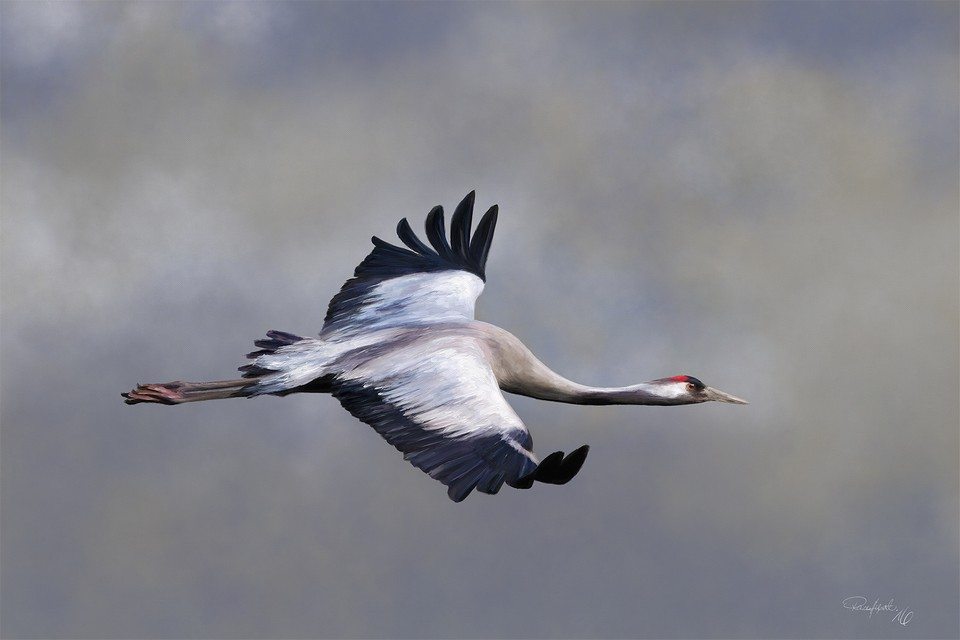
What ArtRage works or projects are you most proud of?
As I have said before, it is mostly horses I work with, because I feel a great connection to them, and their welfare is a force in my art.
“The Malemuck On Napoléon’s Throne” is an early ArtRage piece, and while I didn’t get it all right, it is a very important picture for me. The Malemuck is my own dog, she is one of the rescued Spanish Sighthounds we are blessed to be living with. Hardly anyone knows her like I have shown her here – regal, at ease. Unspeakable things have been done to her, and often times she has to battle flashbacks of panic and fear. It is not the best painting I have done, but it is the one that is most personal. It shows The Malemuck as she really is when all the signs of evil which humanity has forced on her are stripped away.
Auf welche ArtRage-Arbeiten oder -Projekte bist du am meisten stolz?
Wie ich schon gesagt habe, arbeite ich hauptsächlich mit Pferden, weil ich mich ihnen sehr verbunden fühle, und ihr Wohlergehen ist eine treibende Kraft in meiner Kunst.
„Das Malemuck auf dem Thron von Napoléon“ ist ein frühes ArtRage-Bild von mir, und obwohl da nicht so alles stimmt, ist es doch ein sehr wichtiges Bild für mich. Sie ist mein eigener Hund, einer der Spanischen Windhunde vom Tierschutz, mit denen wir das Glück haben, leben zu dürfen. Kaum jemand kennt sie so, wie ich sie hier gezeigt habe – majestätisch, gelassen. Unsagbare Dinge hat man ihr angetan, und noch oft hat sie mit Flashbacks von Panik und Angst zu kämpfen. Es ist nicht das beste Bild, das ich je gemalt habe, aber es ist das persönlichste. Es zeigt das Malemuck, wie sie wirklich ist, wenn alle Zeichen des Bösen abfallen, das ihr die Menschheit angetan hat.
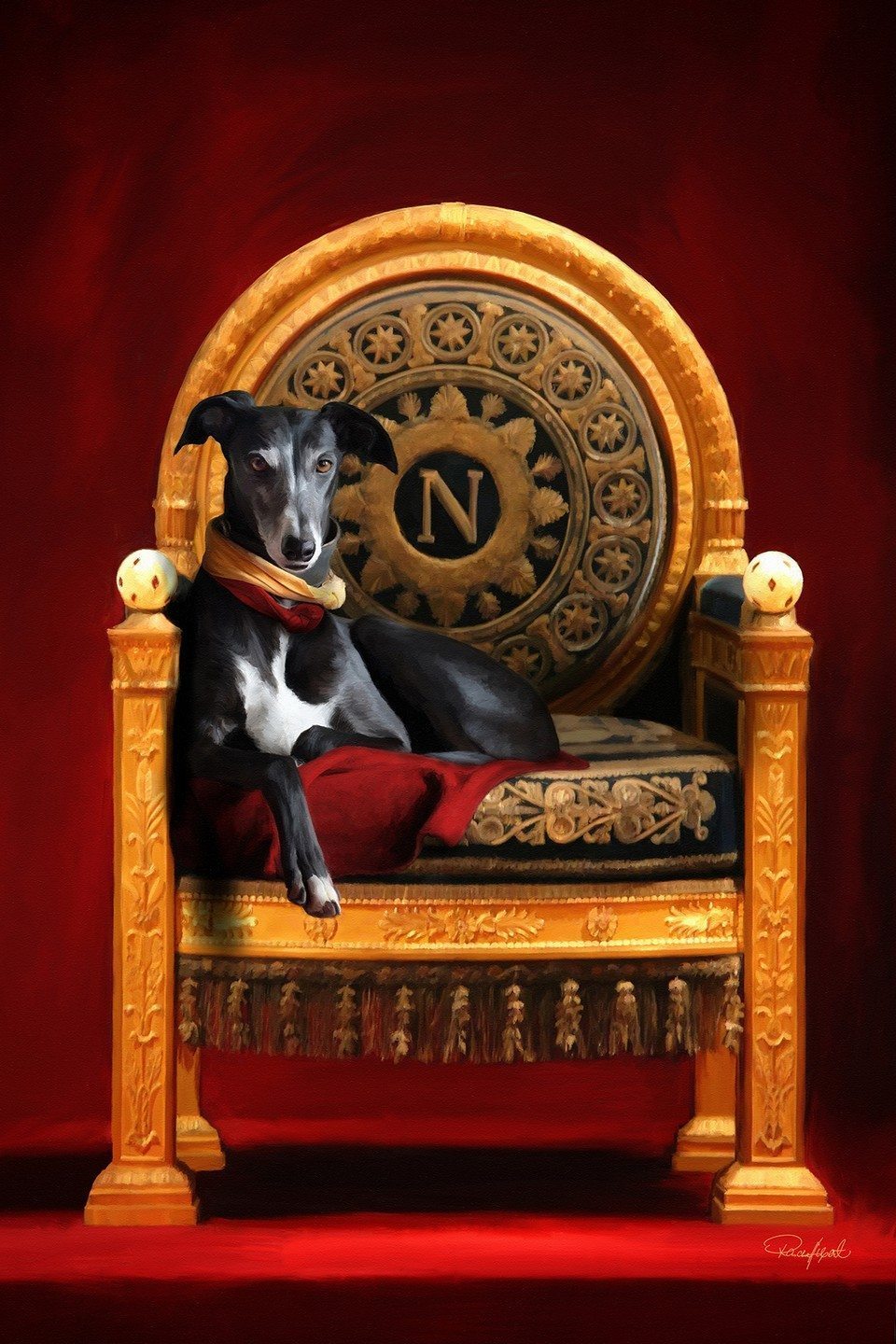
How do you choose what to draw? Are you trying to tell a particular story, convey a certain meaning, or just basing it on what looks good? What response do you try and get from people?
It’s horses, almost always horses, because I have to. It’s what I do, I cannot not do it. It’s the indebtedness to them I have described above that lends my paintings purpose, yes. No story, only the elevation of the individual.
Sometimes I enjoy painting just for the beauty of what has caught my attention. Like the birds here. A goose and a crane. They were guests in our pastures on the farm. Both stayed for a few weeks, returning every morning.
I don’t like to paint anything that I haven’t been a part of.
In the future, I would like to do landscapes, but I am not there yet.
I have learned not to rely on responses too much. Some artists are very good at gathering a large following. Me – not so much 😉 Almost all of my paintings are private commissions. They have great personal significance to the owners of the horses, and that’s most important to me.
Wie entscheidest du, was du malst? Versuchst du, eine bestimmte Geschichte zu erzählen, eine Bedeutung zu vermitteln, oder malst du einfach, was schön ist? Welche Reaktion versuchst du hervorzurufen, und bekommst du sie von den Betrachtern deiner Bilder?
Es sind Pferde, fast immer Pferde, weil ich es einfach tun muss. Das ist es, was ich tue, ich kann es nicht nicht tun. Es ist die Verpflichtung, die ich weiter oben beschrieben habe, die meinen Bildern eine Bedeutung verleiht, ja. Keine Geschichte, einfach nur die Erhöhung des Individuums.
Manchmal gefällt es mir aber auch, einfach nur etwas zu malen, dessen Schönheit mir ins Auge gefallen ist. Wie die Vögel hier. Eine Gans und ein Kranich. Sie waren einige Wochen lang Gäste auf unseren Koppeln. Beide kamen jeden Morgen wieder.
Ich mag nichts malen, von dem ich nicht selbst ein Teil war.
In der Zukunft möchte ich auch Landschaften malen, aber so weit bin ich noch nicht.
Ich habe gelernt, Reaktionen nicht zu viel beizumessen. Einigen Künstlern gelingt es, zu ein großen Gefolgschaft zu gelangen. Ich – näh, nicht so sehr 😉 Fast alle meiner Bilder sind private Auftragsarbeiten. Sie haben eine große Bedeutung für die Besitzer der Pferde, und das ist mir am wichtigsten.
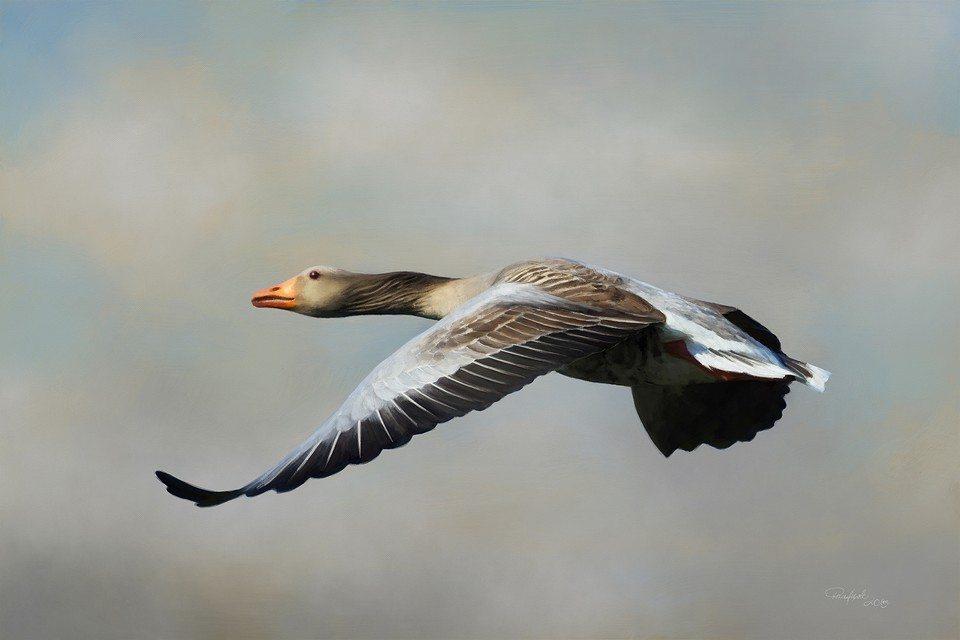
Why do you use ArtRage?
Because it makes me forget that I am working digitally.
I love that ArtRage is fuss-free. Yes, it may be limited in so far as that it doesn’t offer a myriad of brushes to create special effects right out of the box. BUT, it makes you think, it makes you dig deeper, it is like a teacher who tells you to find your way of expression within you, not stuffed in a toolbox or in a jar of brushes. ArtRage makes me work, and yes, that can be frustrating, but the result is mine, not the reproduction of a style hidden in a brush with what seems a life of its own. ArtRage has made me the gift of finding a way to myself.
Where does ArtRage fit into your workflow? (Do you use it for the entire painting or for certain parts of paintings?)
I use it for entire paintings, yes.
Warum benutzt du ArtRage?
Weil es mich vergessen lässt, dass ich digital arbeite.
Ich liebe die Tatsache, dass ArtRage unkompliziert ist. Ja, es mag sein, dass es insofern beschränkt ist, als dass es einem keine ausgesprochene Vielzahl von Brushes bietet, um damit spezielle Effekte ohne viel Zutun zu erzielen. ABER, es regt einen zum Denken an, es lässt einen nach Verborgenem graben, es ist wie ein Lehrer, der einem zeigt, dass Ausdrucksweise etwas ist, dass in einem selbst ist, nicht in einem Werkzeugkasten oder einem Becher voller Pinsel. ArtRage lässt einen arbeiten, und das ist manchmal frustrierend, aber das Resultat gehört einem selbst, es ist nicht die Reproduktion eines Stils, der verborgen in einem Werkzeug liegt, das sein eigenes Leben zu haben scheint. ArtRage hat mir das Geschenk gemacht, mich selbst zu finden.
Wie lässt sich ArtRage in deinem Arbeitsprozess unterbringen? (Benutzt du es für ganze Gemälde oder für bestimmte Aspekte in deiner Herangehensweise an das Malen?)
Ich nutze ArtRage für ganze Gemälde.
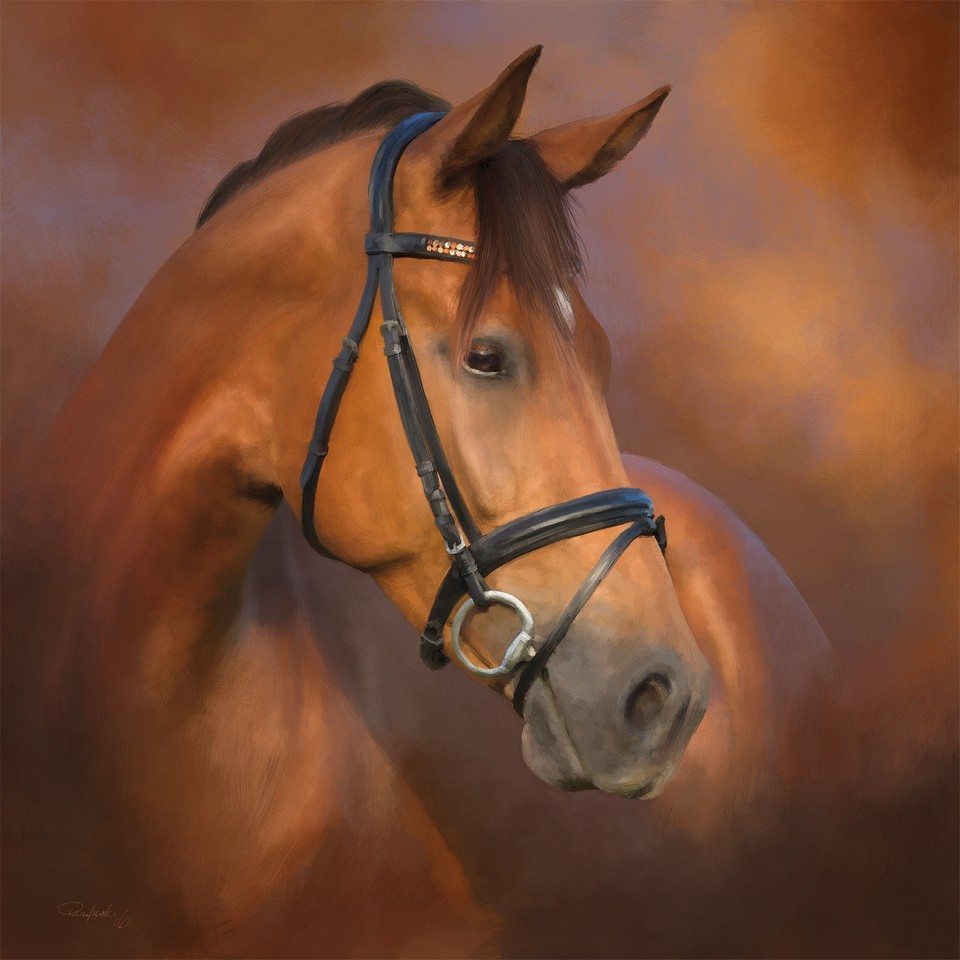
How would you normally paint a picture? What is your process?
I can’t really draw free-hand. I start my work with my camera, and I use my own photographs as references. Actually, I see my camera as a sketch book for my paintings. Yes, it is also a sole tool for purely photographic art and for private and commercial commissions, but for my paintings, it’s my sketch book. I do trace, and to some extent I also color trace in the early stages. When I feel that I have caught the essence, I throw out the tracing image and paint by reference. Interestingly, this point comes earlier and earlier with every painting. ArtRage is teaching me to paint, it is encouraging me to take “risks” to discover the possibilities of wild abandon and modest reduction.
Wie malst du normalerweise ein Bild? Was ist deine Herangehensweise?
Ich kann nicht wirklich gut frei Hand zeichnen. Ich starte meine Arbeit mit meiner Kamera, und ich nutze meine eigenen Fotografien als Referenzen. Tatsächlich ist es so, dass ich meine Kamera als ein Skizzenbuch betrachte. Ja, sie ist auch alleiniges Werkzeug für rein fotografische Kunst und für gewerbliche und private Auftragsarbeiten, aber für meine Gemälde ist sie mein Skizzenbuch. Ich pause (trace), und zu Beginn eines Gemälde mache ich auch Farbpausen (color trace). Wenn ich das Gefühl habe, das Wesentliche eingefangen zu haben, werfe ich die Vorlage fort und male weiter unter Nutzung meines Referenzbildes. Interessanterweise passiert dies mit jedem Gemälde früher und früher. ArtRage lehrt mich zu malen, es ermutigt mich, „Risiken“ einzugehen, um die Möglichkeiten wilder Freizügigkeit und bescheidener Reduzierung zu entdecken.

What are your favourite ArtRage features?
Definitely the Oil Brush, the Paint Tube and the Palette Knives. I am starting to use more of the Pencil and the Chalk and Wax, but I am not sure yet where this will take me.
The tracing options are great and important to me, obviously, and I love that ArtRage handles large canvases so very well. I paint to print, and some of my prints are rather large. “A Family Of Its Own” is two meters wide, the working file was 1.2GB at the end. The portrait of the blue-eyed stallion is 1.6 by 1.2 meters. I have no great knowledge of the insides of a computer, but I paint at 300ppi, I am working on an old computer, and ArtRage never complains, so I feel pretty safe in saying that stability counts among the very best of ArtRage’s features.
What I really love about ArtRage is the elegant simplicity of it. Eliminating everything from the screen in Workbench Mode to be left alone with your current tool and your painting is a gift of such value as you may not even be aware of. This design allows me to be free of emotional ties to my computer – it no longer matters that I sit at my desk, I am able to immerse myself in the image I am working on. It’s a gift of freedom.
Least used?
The Gloop Pen and Glitter.
Was sind aus deiner Sicht die besten Eigenschaften von ArtRage?
Auf jeden Fall der Ölpinsel, die Farbtube und die Malmesser. Ich benutze auch die Bleistifte und die Kreiden immer mehr, aber ich bin mir noch nicht sicher, wo mich das hinführt.
Die Optionen zu Pausen ist großartig und für mich offensichtlich wichtig, und ich finde es beeindruckend, wie gut ArtRage mit großen Leinwänden zurecht kommt. Ich male für den Druck, und einige meiner Bilder sind recht groß. „A Family Of Its Own“ ist zwei Meter breit, die Arbeitsdatei war 1,2GB groß. Das Portrait des blauäugigen Hengstes ist 1,60m x 1,20m. Ich habe keine echte Ahnung von Computern, aber ich male bei 300ppi, ich arbeite an einem alten Computer, und ArtRage beschwert sich nie – also fühle ich mich recht sicher mit der Behauptung, das ArtRage ein sehr stabiles Programm ist.
Was benutzt du am wenigsten?
Den Gloop Pen und Glitter.
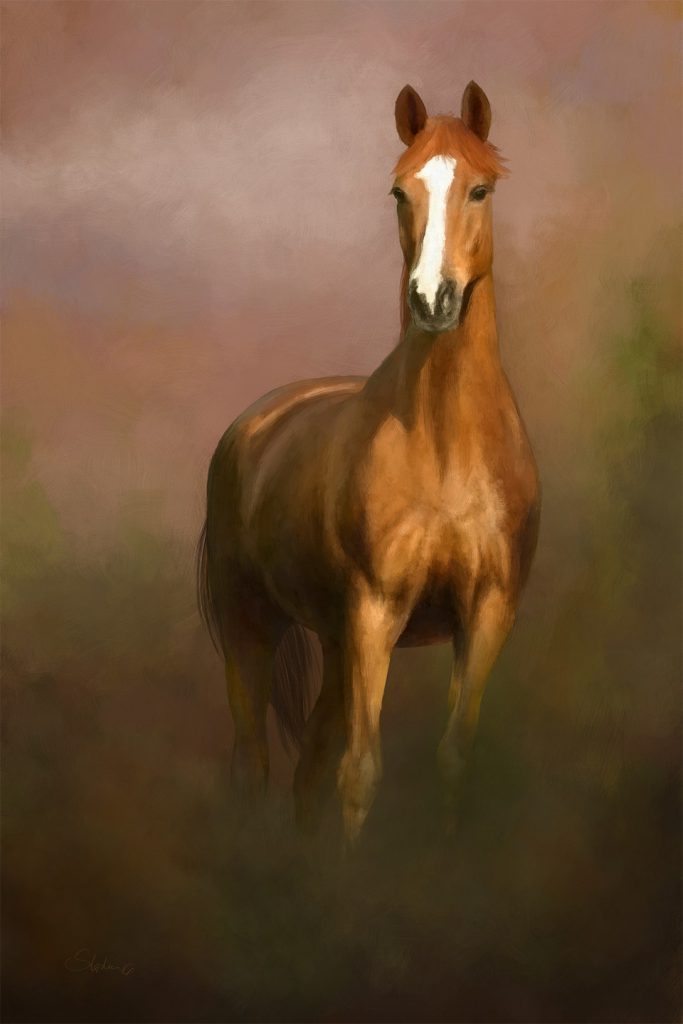
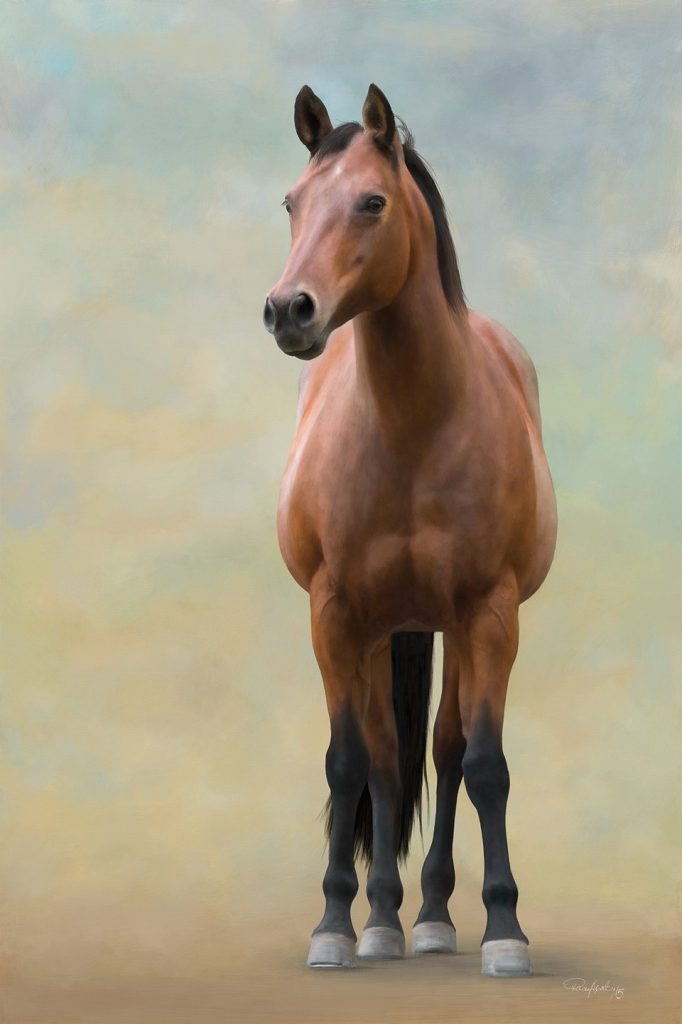
Do you have any tips for other artists who might want to do the same thing as you?
For painting horses – as with anything, really – I feel it is necessary to have an understanding of your subject in general and your motif in particular; there should be a connection. I suppose that can happen on many different levels, but for me, it is vital to have a good amount of knowledge of what I am painting, else I am lost very quickly. I have noticed this in paintings I started and left unfinished.
I work with my own photography as the basis for my paintings. I travel (often far) to meet a horse, I work with it, I get to know it, I talk to its people, I share an experience with it. All of this figures in when I paint it. I am recreating an emotion, trying to use it as a means of portraying the essence of a horse as an individual.
If you aren’t great at drawing free-hand like I am not, use your ability as a photographer to substitute for that. Work at creating something meaningful in a photograph, be serious about it and take it from there. I feel there is no shame in tracing. Having made the capture is an act of creation, it is all your own.
Hast du Tipps für andere Künstler, die eventuell das gleiche machen möchten wie du?
Wenn man Pferde malt, finde ich es wichtig – wie eigentlich auch bei allem anderen – ein Verständnis von seinem Thema und seinem Motiv zu haben; es sollte eine Verbindung sein zwischen dem, der malt und dem, was er malt. Ich vermute, dass dies auf ganz unterschiedlichen Ebenen der Fall sein kann, aber für mich ist es unerlässlich, Wissen von dem zu haben, was ich male, ansonsten verliere ich schnell den Überblick. Ich habe das bei Bildern bemerkt, die ich zwar in Angriff genommen, aber nie zu Ende gebracht habe.
Ich arbeite mit meinen eigenen Fotografien als Ausgangspunkt für meine Gemälde. Ich reise (of weit) zu einem Pferd, ich arbeite mit ihm, ich lerne es kennen, ich spreche mit seinen Menschen, ich teile ein Erlebnis mit ihnen. All das fließt mit in die Entstehung eines Bildes ein. Ich lasse eine Emotion aufleben, und ich versuche sie zu benutzen, um das Wesen eines Pferdes als Individuum zu portraitieren.
Wenn dir das Zeichnen frei Hand nicht leicht fällt, so wie es mir das nicht tut, nutze deine Fähigkeiten als Fotograf, um dies zu ersetzen. Arbeite daran, etwas Bedeutsames in einer Fotografie zu erschaffen, nimm es ernst, und entwickle es von dort aus weiter. Ich bin der Meinung, dass Pausen keine Schande ist. Eine Aufnahme zu machen, ist ein schöpferischer Akt – sie gehört ganz dir.
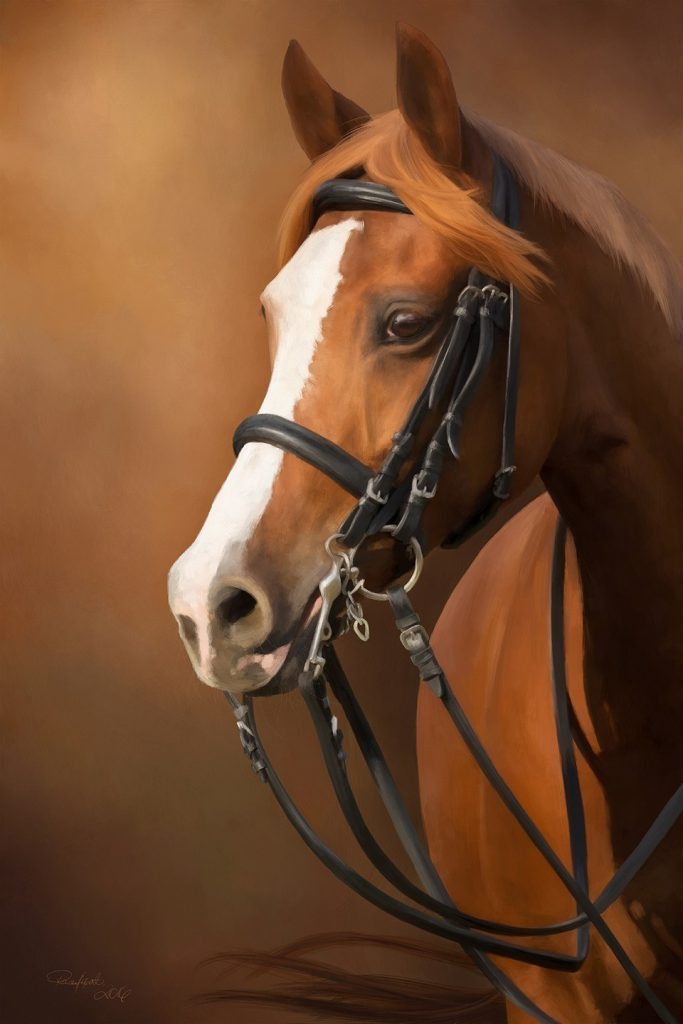
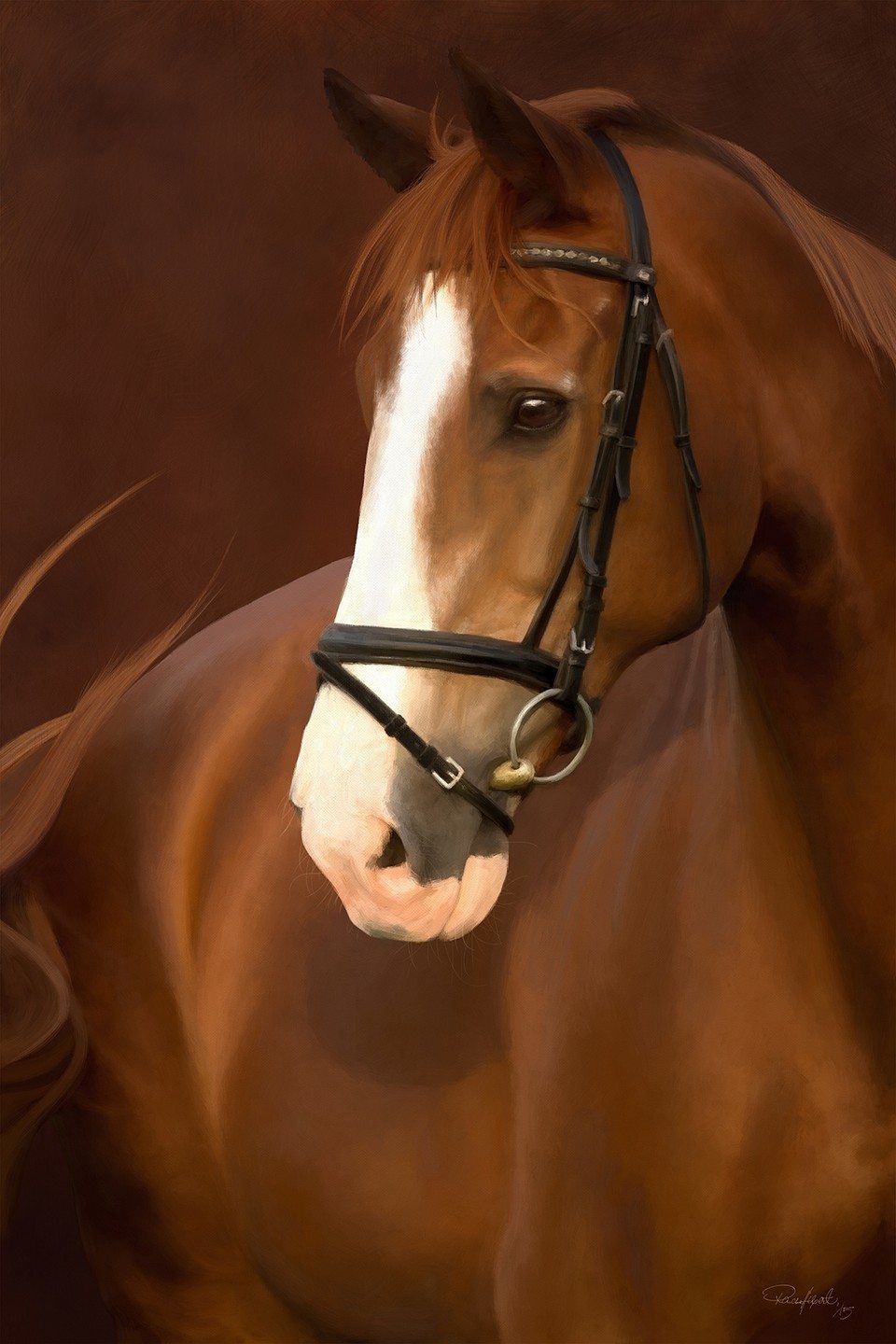
Any ArtRage specific tips?
Be daring, explore. Use layers, and there is always Undo. DON’T feel discouraged or fooled by what seems a meagre array of brushes compared to other programs. It is not. Imagine what traditional media painters and the old masters achieved with simple brushes and paint on canvas. You can do that, too! It is exciting to find your own way of using the natural feel and abilities of the tools you find in ArtRage. They can be adjusted to a very high degree, but don’t expect brushes to do the work you would rather be able to do yourself. There is great satisfaction in finding your own way.
Irgendwelche besonderen Tipps in Bezug auf ArtRage?
Sei mutig, mach Entdeckungen. Benutze Ebenen, und es gibt immer einen Schritt zurück. Lass dich NICHT davon entmutigen oder verwirren, dass es zuerst aussieht, als würde dir nur eine dürftige Auswahl an Werkzeugen geboten. Es stimmt nicht. Überlege, was traditionelle Künstler und die Alten Meister mit einfachen Pinseln und Farbe auf die Leinwand gebracht haben. Das kannst du auch! Es ist aufregend und spannend, seine eigene Art und Weise zu entwickeln, die Möglichkeiten der sich wirklich natürlich anfühlenden Werkzeuge von ArtRage anzuwenden. Sie können zu einem hohen Grad verändert und angepasst werden, aber erwarte nicht, dass sie die Arbeit für dich erledigen, die du viel lieber selbst machen können möchtest. Es liegt eine große Befriedigung darin, seinen eigenen Weg zu finden.
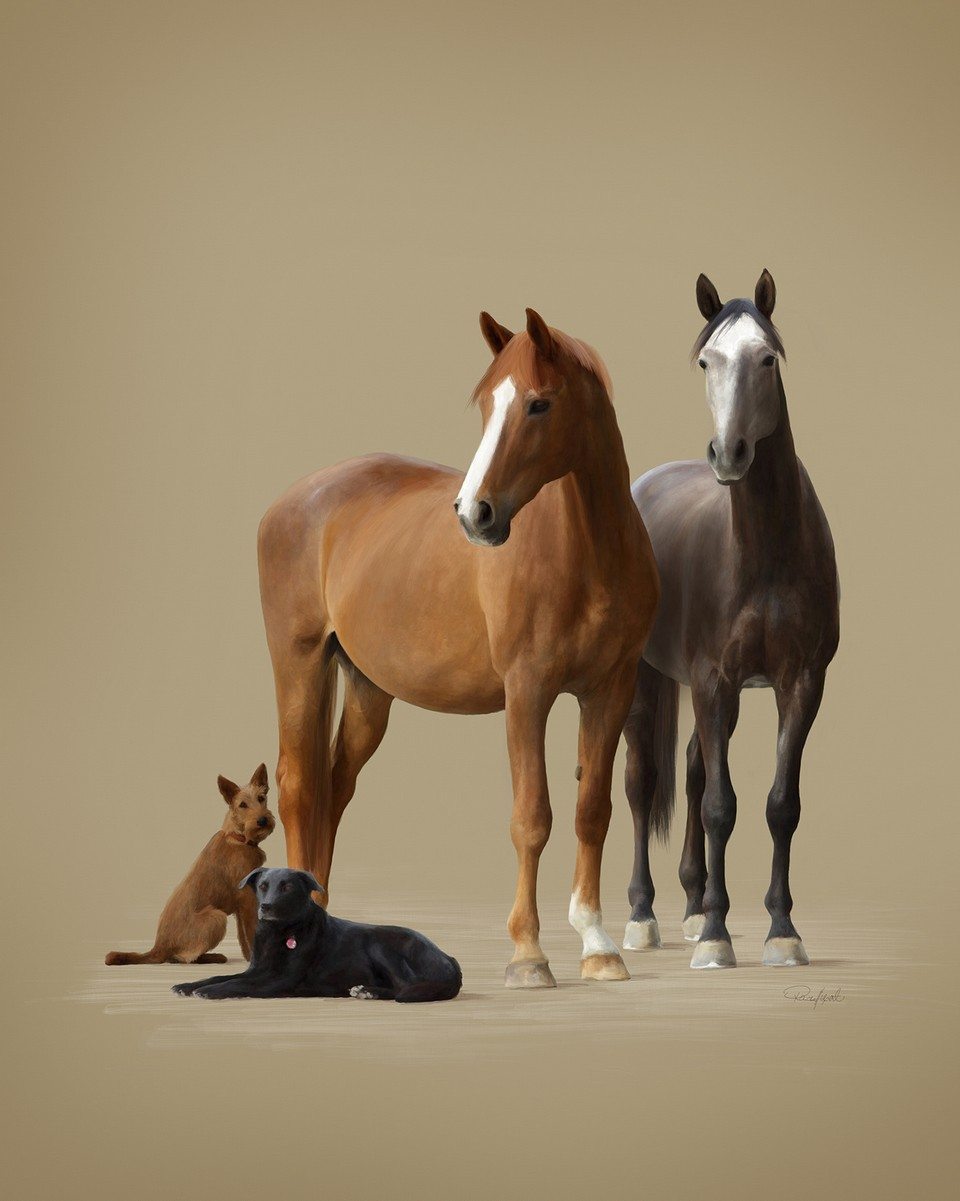
Would you recommend ArtRage for professional artwork?
Yes, I would. I use it for commissions, and that is professional work. I have seen breathtaking illustrations, concept art and individual pieces of art done in ArtRage. If you connect with the program and its tools, there is no way not to think that it is more than suitable for professional work.
Any question(s) you wish we’d asked and would like to answer?
Nope, not really. I am still blown by the fact that you are asking me the ones I have been answering!
Würdest du ArtRage für professionelle Arbeiten empfehlen?
Ja. Ich male meine Auftragsarbeiten in ArtRage, und das ist professionelle Arbeit. Ich habe atemberaubende Illustrationen gesehen, Concept Art und eigenständige Kunstwerke, die in ArtRage gemalt wurden. Wenn es gelingt, sich auf das Programm und seine Werkzeuge einzulassen, gibt es keine Frage – dann ist ArtRage mehr als nur geeignet für professionelle Arbeit.
Irgendwelche Fragen, die wir dir hätten stellen sollen und die du gerne beantworten würdest?
Nee, nicht wirklich. Ich bin immer noch total geplättet von der Tatsache, dass ihr mir die gestellt habt, die ich gerade beantwortet habe.
You can view more of Stephen Rasche-Hilpert’s work on his website at www.equidographie.de and follow him on his Facebook and Facebook Page
Note: While Stephen currently does not have an English website (although he is working on one), you can browse his site using Google Translate to read it in English.